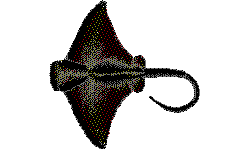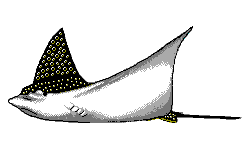The bat ray digs up food with its wings and snout, and will even bite off overhanging ledges to get at prey. It hunts singly or in groups. When resting, it buries itself in sand with just the eyes protruding.
Edibility is poor.
Range is from Oregon to the Gulf of California.

This ray is an active swimmer and often leaps into the air. The slapping sound it makes on the water is thought to mark a territory.
Edibility is poor.
Range is throughout the tropics.
